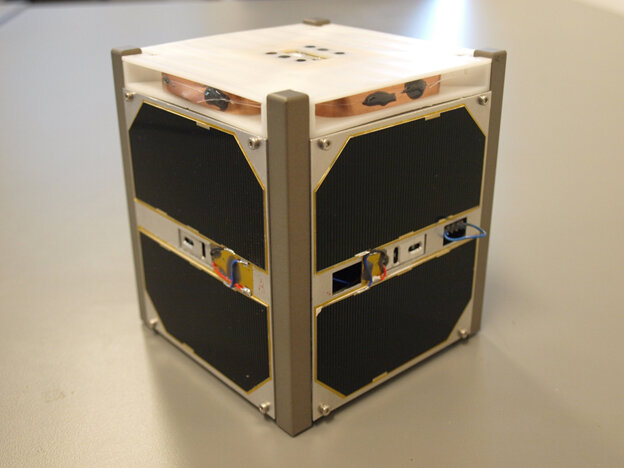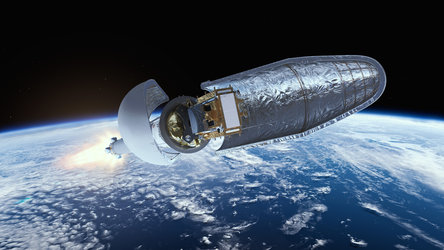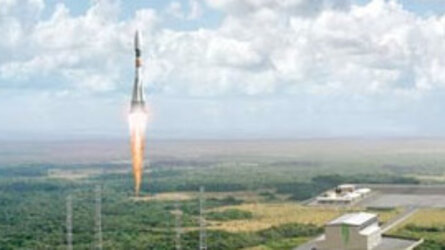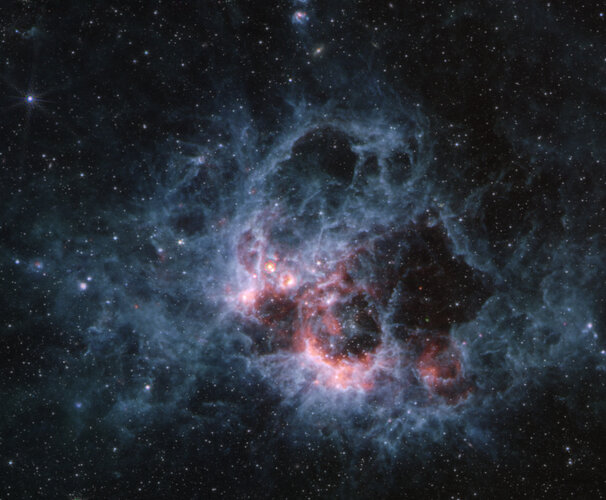Student teams to launch
Three student-built CubeSats - OUFTI-1, Belgium; e-st@r-II, Italy; AAUSAT4, Denmark - have been accepted for launch on the Soyuz VS14 flight from the European Spaceport in Kourou, French Guiana. Together with CNES’ MICROSCOPE scientific satellite, they will be auxiliary payload in the launch of the ESA Earth observation satellite Sentinel 1B, the main passenger on this flight.
AAUSAT4, Aalborg University, Denmark

AAUSAT4 is part of a continuous educational programme – AAUSAT – established at the University of Aalborg, Denmark. The AAUSAT5 student-built CubeSat, based on a design very similar to AAUSAT4, was released into orbit from the International Space Station on 5 October 2015, also as part of the ESA FYS! Programme.
AAUSAT4 is funded nationally by the University of Aalborg with the support of national sponsors such as Sparnord Fonden, Søfartsstyrelsen, Printca, Marel Denmark, Hytek Aalborg (main sponsors), and Satlab ApS, Mekoprint, Cobham, Rohde-Schwarz.

AAUSAT4 will conduct in-orbit testing of an improved version of the Automated Identification System (AIS) receiver, a system developed by the Aalborg students to track and identify ships and other vehicles carrying an AIS transponder, which are transiting away from coastal areas and in remote areas, to enable safer use of new shipping lanes.
| AAUSAT4, Aalborg University, Denmark | |
| Spacecraft name: | AAUSAT4 |
| – Mass at launch: | 850g |
| – Dimensions: | ~10cm x 10cm x 11cm |
| – Power: | 1.5 W |
| – Solar arrays dimension: | 6 solar arrays of approx.8x8 cm (body mounted) |
| Mission: | |
| – Launch date: | 25 April 2016 |
| – Operational orbit: | Elliptical approx. 454 x 682 km, inclination 98.2 deg (polar) |
| – Mission lifetime: | Design: 1 year |
| – Ground stations: | Aalborg University (operated by students) |
| Payload: | |
| – AIS | Automatic Identification System |
e-st@r-II, Politecnico di Torino, Italy

e-st@r-II is part of a continuous educational programme – e-st@r - established at the Politecnico of Torino, Italy, as an effective means for educating aerospace engineering students. e-st@r-I was launched on the Vega Maiden Flight on 12 February 2012, as part of the first ESA CubeSats programme, direct precursor of the Fly Your Satellite! Programme. The e-st@r student team is coordinated by ASSET (AeroSpace Systems Engineering Team) of the Mechanical and Aerospace Engineering Department of Politecnico di Torino, and makes use of their university’s System and Technologies for Aerospace Research Laboratory (STARLab).
e-st@r-II (Educational SaTellite @ politecnico di toRino - II) is self-funded nationally through the Student Projects Grants initiative of the Politecnico di Torino.

The objective of e-st@r-II is to demonstrate autonomous active attitude determination capabilities based on a system that makes use of the Earth’s magnetic field (A-ADCS). During the commissioning phase, the payload will be deactivated, leaving the satellite in its free tumbling motion, without any attitude stabilization. The A-ADCS will then kick-in by interacting with the Earth magnetic field in order to demonstrate it can actively de-tumble the satellite’s angular velocities, and it can properly determine the satellite attitude.
| e-st@r-II, Politecnico di Torino, Italy | |
| Spacecraft name: | e-st@r-II |
| – Mass at launch: | 980g |
| – Dimensions: | ~10cm x 10cm x 11cm |
| – Power: | 2.75 W |
| – Solar arrays dimension: | 5 solar arrays of approx.7x8 cm (body mounted) |
| Mission: | |
| – Launch date: | 25 April 2016 |
| – Operational orbit: | Elliptical approx. 454 x 682 km, inclination 98.2 deg (polar) |
| – Mission lifetime: | Minimum: 3 months |
| – Ground stations: | Radio Amateurs, Bra, Cuneo, Italy |
| Payload: | |
| – A-ADCS | Active Attitude Determination and Control Subsystem |
OUFTI-1, University of Liège, Belgium

OUFTI-1 will be the first Belgian student-built satellite, the first Belgian CubeSat, the first satellite fully conceived, built, managed and operated in Belgium, and the world’s first satellite featuring D-STAR radio communications. It has been developed at the University of Liège (ULg), Belgium, with assistance from the industrial engineering schools HEPL-ISIL and HELMO-Gramme, both from Liège, Belgium.
OUFTI-1 is funded nationally mainly by the Belgian Science Policy Office (BELSPO) and the University of Liège.

The objective of OUFTI-1 is to test its innovative payload, the D-STAR digital radio communication (sub)system; this is a recently-developed amateur radio protocol that provides several built-in advanced features, allowing digital communication, simultaneous voice and data transmission (e.g., GPS data and computer files), complete routing over the internet, and roaming on a worldwide basis. OUFTI-1 will implement the first D-STAR repeater in space.
| OUFTI-1, University of Liège, Belgium | |
| Spacecraft name: | OUFTI-1 |
| – Mass at launch: | 920g |
| – Dimensions: | ~10cm x 10cm x 11cm |
| – Power: | 2 W |
| – Solar arrays dimension: | 5 solar arrays of approx. 8x8 cm (body mounted) |
| Mission: | |
| – Launch date: | 25 April 2016 |
| – Operational orbit: | Elliptical approx. 454 x 682 km, inclination 98.2 deg (polar) |
| – Mission lifetime: | Design: 1 year |
| – Ground stations: | University of Liège (operated by students) |
| Payload: | |
| – D-STAR | Digital Smart Technology for Amateur Radio |















 Germany
Germany
 Austria
Austria
 Belgium
Belgium
 Denmark
Denmark
 Spain
Spain
 Estonia
Estonia
 Finland
Finland
 France
France
 Greece
Greece
 Hungary
Hungary
 Ireland
Ireland
 Italy
Italy
 Luxembourg
Luxembourg
 Norway
Norway
 The Netherlands
The Netherlands
 Poland
Poland
 Portugal
Portugal
 Czechia
Czechia
 Romania
Romania
 United Kingdom
United Kingdom
 Slovenia
Slovenia
 Sweden
Sweden
 Switzerland
Switzerland































